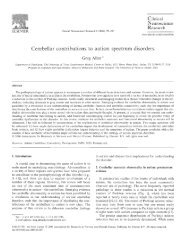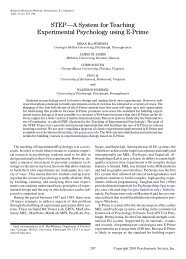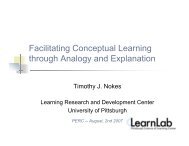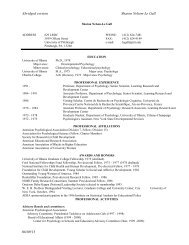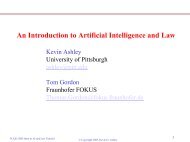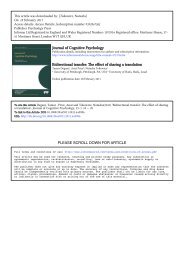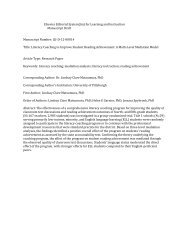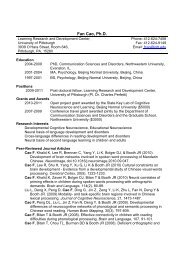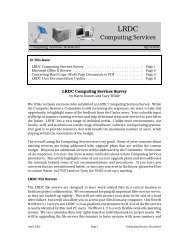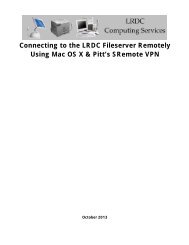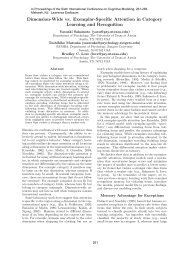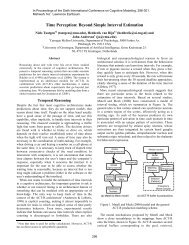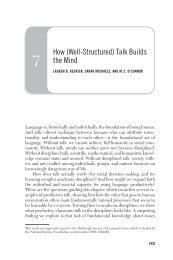FIGURE 6. Three-level conceptual model of K–12 district system with process feedback. Source: L. B. Resnick, M. Besterfield-Sacre, M. M.Mehalik, J. Z. Sherer, and E. R. Halverson. (2007). A framework <strong>for</strong> effective management of school system per<strong>for</strong>mance. In P. A. Moss (Ed.),Evidence and decision making: The 106th yearbook of <strong>the</strong> National Society <strong>for</strong> <strong>the</strong> Study of Education (NSSE) (Part I, pp. 155–185).Malden, MA: Blackwell.To <strong>the</strong> left in Figure 7 are hypo<strong>the</strong>sized enablers (sometimesconstraints) that <strong>the</strong> school or district introduces (some of <strong>the</strong>processes fall between district and school or between school andclassroom). The research basis <strong>for</strong> <strong>the</strong> elements fur<strong>the</strong>r to <strong>the</strong> leftin <strong>the</strong> diagram is much thinner than <strong>for</strong> classroom processes, but<strong>the</strong>re is widespread agreement in <strong>the</strong> policy making and policyresearch communities that each of <strong>the</strong> elements named is potentiallyimportant. In fact, many proposed policy initiatives arebased on assumptions involving <strong>the</strong>se elements (e.g., hire andreward teachers with more knowledge and skill, provide continuingprofessional development, modify principal hiring and schoolassignment policies).To check our hypo<strong>the</strong>sized process model against <strong>the</strong> implicitmodels of leaders in urban school districts, we invited key decisionmakers in several urban school districts to participate in aseries of mapping exercises. More than 100 urban district officials(including superintendents, deputy superintendents, chiefacademic officers, instructional supervisors, and principals) participated.Participants were given a set of “tiles,” each containingone of <strong>the</strong> elements in Figure 7. They were permitted to discardany elements <strong>the</strong>y did not deem centrally important and to addnew ones, if necessary, to reflect <strong>the</strong>ir views. Participants wereasked to create “influence maps” of <strong>the</strong>ir policies aimed atimproving student learning. Twenty-eight groups of district officialscreated 28 different maps using our organizational elementsand enablers plus a small number of additional ones that<strong>the</strong>y added.Although <strong>the</strong>re were variations among <strong>the</strong> maps, certaincharacteristics were largely shared. First, our hypo<strong>the</strong>sized systemelements did, according to our participants, constitute <strong>the</strong>fundamentals of <strong>the</strong> K–12 system. Even though district leaderswere instructed to add additional elements as needed, fewwere added, and <strong>the</strong>re was no consistency among <strong>the</strong> additions.In addition, <strong>the</strong> pattern of influence revealed in <strong>the</strong> 28separate practitioner maps was quite similar to what is shownin Figure 7.We combined <strong>the</strong> qualitative knowledge embodied in our districtexperts’ graphs using an algorithmic approach involving arecursive path-counting routine written in VB.NET (Clark,Sherer, Besterfield-Sacre, & Resnick, 2007). The results of <strong>the</strong>VB.NET analyses identify frequently occurring paths among <strong>the</strong>28 maps developed by our school district participants. Thesepaths represent prominent shared <strong>the</strong>ories of action among ourexperts <strong>for</strong> how to influence classroom processes to produceimproved student learning. Four high-frequency two-elementpaths were identified:Instructional leadership → teacher beliefsQuality of professional community → teacher beliefsProfessional development → teacher knowledge and skillSchool calendar → instructional scheduleFur<strong>the</strong>r, four individual elements (instructional leadership,quality of professional community, teacher beliefs, teacherDownloaded from http://er.aera.net at UNIV OF PITTSBURGH on March 30, 2012april 2010 189
FIGURE 7. Fundamental elements of <strong>the</strong> K–12 system according to participant practitioners.knowledge and skill) also appeared in frequently identified pathsof three, four, or five elements. All 28 groups placed teacherbeliefs in <strong>the</strong>ir diagrams. All but one included teacher knowledgeand skill. Instructional leadership, quality of professional community,and professional development were used with high frequency.Thus, according to our participants, <strong>the</strong>re is a solid coreof processes essential to enabling <strong>the</strong> classroom practices that weknow produce student learning.Policy Planning: The New Re<strong>for</strong>m TriangleAlthough <strong>the</strong> terms human capital and social capital had deliberatelynot been used in our mapping exercises (to avoid havingtechnical terms block our experts’ ability to articulate <strong>the</strong>ir own<strong>the</strong>ories of action), <strong>the</strong> education leaders we worked with shared<strong>the</strong> underlying ideas expressed by those terms. Our participantsaffirmed <strong>the</strong> importance of organizational features of schools thatsocial scientists and policy experts have been addressing <strong>for</strong> sometime: human capital (expressed as “teacher knowledge and skill,”“teacher beliefs,” and “instructional leadership”) and social capital(expressed as “quality of professional community” and “ef<strong>for</strong>tbasedinstructional culture”). To <strong>the</strong>se two terms, we add a third:instructional tools and routines (expressed as “appropriate assessmentsavailable,” “curriculum and materials,” “professionaldevelopment”). These three organizational features comprise anew policy triangle (see Figure 8) that is beginning to guide policydesigns <strong>for</strong> improved achievement—although it is rare <strong>for</strong>advocates or scholars to consider <strong>the</strong> three in combination.Human CapitalEconomists tend to be especially interested in human capital:what people in <strong>the</strong> organization know and know how to do(Harbison & Hanushek, 1992). Human capital is typically measuredby credentials, per<strong>for</strong>mance observations, and individualoutputs (in education, student learning). Economists have relatedFIGURE 8. Policy triangle to guide policy design in educationalsettings.190educational ResearcherDownloaded from http://er.aera.net at UNIV OF PITTSBURGH on March 30, 2012



